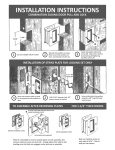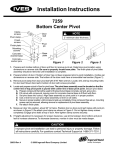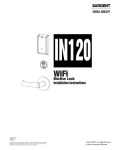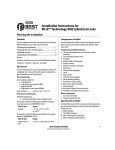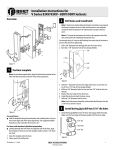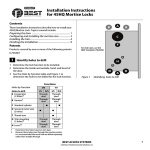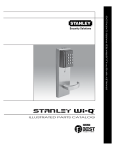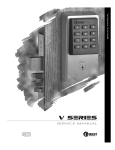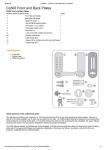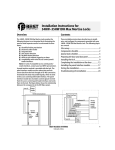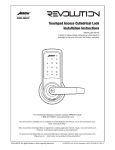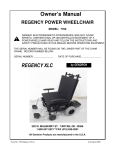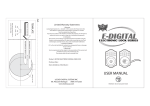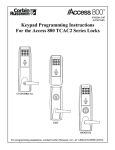Download Installation Instructions for V Series Mortise Locks (brass)
Transcript
Installation Instructions for V Series 34HV–35HV Locksets Overview 2 Mark the vertical centerline of the lock on the door’s edge. 3 Mark the vertical centerline of the lock on both sides of the door as measured from the vertical centerline on the door’s edge. 4 Mark the horizontal centerline of the strike on the door jamb 3/8“ above the horizontal centerline of the lock. 2 Position template 1 Cut the template along the dotted line and align the horizontal and vertical arrows to the marked centerlines on the door. 2 Tape the template onto the door. 3 Center punch the drill points. Figure 1 1 Mark centerlines Note 1: If the door is a fabricated hollow metal door, determine whether it is properly reinforced to support the lock. If the door reinforcement is not adequate, consult the door manufacturer for information on proper reinforcement. Note 2: The suggested height from the floor to the centerline of the knob/lever is 38“. 1 Mark the horizontal centerline of the lock on both sides of the door and on the door’s edge. Recommended door/jam gap ~ 1/8“ Figure 3 3 Mortise for lock case and front Mortise the edge of the door to accommodate the lock case and face plate. 2 3/4“ backset Mortise case Vertical centerline of cylinder and knob/lever Centerline of strike 1 1/2“ 3/8“ Vertical centerline of door edge and lock front Figure 2 T61853/Rev – 1852819 ER-7991-1 Horizontal centerline of lock Horizonal centerline of knob/lever (recommended height 38“ from floor) Figure 4 BEST ACCESS SYSTEMS Indianapolis, Indiana 1 4 6 Drill holes Caution: Check the lock for the correct function, hand, and bevel before drilling. Drill only those holes required for the function. Wire hole 7/8“ dia. Cylinder hole 1 1/4“ dia. Install mounting plates 1 Insert the outside mounting plate through the door and lock case. 2 Position the inside mounting plate opposite the outside mounting plate and screw them securely in place. Caution: Do not overtighten the mounting plate screws. Overtightening may compress the mortise cavity and bind the locking mechanism. 8 Install trim hole inserts and bushings 1 Insert the two trim hole inserts into the upper trim hole on each side of the door. 2 Insert the two bushings into the wire hole on each side of the door (see Figure 10). Bushing Knob/lever hole 7/8“ dia. Trim hole insert Throughbolt holes 3/8“ dia. Inside mounting plate Figure 5—RH and RHRB hole pattern Trim hole 5/8“ dia. Outside mounting plate Turn knob hole 1/2–5/8“ dia. Figure 8 Trim hole 5/8“ dia. Wire hole 5/8“ dia. 7 1 Figure 6—LH and LHRB hole pattern 5 Install mortise case 1 Remove the faceplate from the mortise case. 2 Install the mortise case while feeding the motor wire and deadbolt sensing wire (deadbolt function only) into the mortise cavity and out the wire hole (see Figure 7). Deadbolt sensing wire 2 3 4 Bushing Trim hole insert Install cylinder Caution: A malfunction can occur if the cylinder is threaded in too far. Thread the concealed cylinder into the lockset so that the groove around the cylinder head is even with the door surface. Adjust the cylinder depth plus or minus one turn so that the core, when installed in the cylinder, will be flush with the outer surface of the trim. Secure the cylinder into the case with the case set screw. Secure the faceplate. Check the cylinder and lock for proper operation. Concealed cylinder Figure 10 9 Make wire connections 1 Feed the outside wire harness connector through the top wire hole (see Figure 11). Case set screw (inside) Outside wire harness connector Motor wire Mortise case Figure 7 3 Secure the mortise case with the case mounting screws. T61853/Rev – 1852819 ER-7991-1 Figure 11 Figure 9 BEST ACCESS SYSTEMS Indianapolis, Indiana 2 2 Temporarily rest the trim on the door by inserting the trim studs into the stud holes. 3 From the inside of the door, connect the motor connector and the optional deadbolt sensing connector to their mating connectors from the circuit board (see Figure 12). 11 Connect battery pack 1 Connect the battery pack to the connector hanging inside the battery compartment. 13 Install inside and outside levers/knobs For both levers and knobs Unscrew the inside spindle one full turn to allow the spindles to turn freely. Outside wire harness Battery pack For levers 1 With the handle pointing toward the door hinges, put the outside lever and spindles into the lockset from the outside of the door. Set screw Motor connector Deadbolt sensing connector Figure 12 4 Making sure that the connector is properly aligned, connect the outside wire harness connector to the lower right circuit board connector in the inside trim. Press firmly on the connector until it is fully seated. 10 Secure escutcheons 1 Pull the excess outside wire harness back through to the outside of the door. 2 Position the inside and outside escutcheons onto the door. 3 Making sure that the trim does not pinch the wires, secure the trim to the door — but do not tighten — with the combination mounting screw at the top mounting hole and with the standard screw at the bottom mounting hole. Figure 14 2 Insert the battery pack into the battery compartment so that the foam will face the battery door. Caution: If installing a lock with the turn knob function, make sure that the battery wires are not rubbing against the turn knob retaining ring. 12 Install battery compartment door 1 Insert the tabs of the battery compartment door into its mating slots and swing the door closed. 2 Secure the battery compartment door with the security screw. Tighten firmly. Spindles Figure 16 2 Slide the inside lever onto the inside spindle and secure it with the set screw. 3 Tighten the trim mounting screws (see Figure 13). 4 Turn the levers to check that they operate smoothly. For knobs 1 From the outside of the door, put the outside knob and spindles into the lockset. Combination mounting screw Set screw cap Set screw Security screw Tabs Standard mounting screw 2 Slide the inside knob onto the inside spindle and secure it with the set screw. 3 Push the set screw cap into the set screw hole. 4 Tighten the trim mounting screws (see Figure 13). 5 Turn the knobs to check that they operate smoothly. Figure 15 Figure 13 T61853/Rev – 1852819 ER-7991-1 Figure 17 BEST ACCESS SYSTEMS Indianapolis, Indiana 3 14 Install strike plate 1 Mortise the door jamb to accommodate the strike box and strike plate. (See Installation Specifications or dimensions, template V03 and H11.) 15 1 Insert the control key into the core and rotate the key 15 degrees to the right. 2 Insert the core into the cylinder with the control key. 3 Rotate the control key 15 degrees to the left and withdraw the key. Caution: The control key can be used to remove cores and access doors. Provide adequate security for the control key. 16 Figure 18 2 Insert the strike box into the mortise in the door frame and secure the strike with screws provided. Caution: The auxiliary bolt must make contact with the strike plate, as shown in Figure 19. The auxiliary bolt deadlocks the latchbolt and prevents someone from forcing the latch open when the door is closed. If the incorrect strike is installed, a lock-in can occur. Install core Test lock To test the lock for proper operation, use the temporary operator card or personal identification number (PIN) that came with the lock. This card or PIN is for temporary use only and once permanent cards or PINs have been programmed for the lock, you should delete the temporary cards or PINs. These temporary operator cards and PINs will only work on factory default V Series locks. For details on programming the lock for access control, refer to the V Series Intelligent Programming Software User Manual or the V Series Handheld Terminal User Manual. For magnetic stripe card electronic locks 1 With the BEST logo facing toward you, insert and remove the temporary operator card (see Figure 20). The green light flashes and the locking mechanism unlocks. 2 Turn the lever/knob and open the door. 3 Insert and turn the key to unlatch the door. For keypad electronic locks 1 Enter the temporary operator PIN 99998. 2 Press ✽. The green light flashes and the locking mechanism unlocks. 3 Turn the lever/knob and open the door. 4 Insert and turn the key to unlatch the door. For proximity card electronic locks 1 Place the temporary operator card in front of the proximity reader (see Figure 21). The green light flashes and the locking mechanism unlocks. 2 Turn the lever/knob and open the door. 3 Insert and turn the key to unlatch the door. Figure 21 If the mechanism doesn’t unlock, refer to the following table. LEDs 1 long tone Strike plate Auxiliary bolt Denied Use the token at a moderate speed. Green stays on Denied Use the temporary operator token, not the temporary communication token. Green flashes Denied Connect the motor wires. Denied Connect the battery and connect the outside wire harness. Figure 19 Figure 20 T61853/Rev – 1852819 ER-7991-1 Sounder Access You should… BEST ACCESS SYSTEMS Indianapolis, Indiana 4





